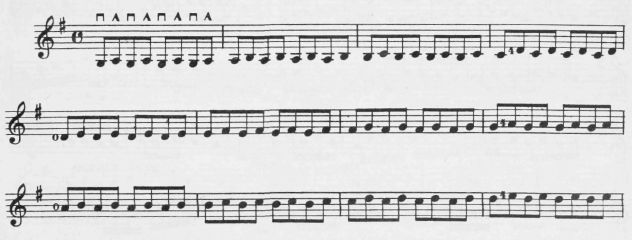Mandolin Self Instructor, online tutorial - Page 37
A simplified self learning system for the Mandolin with tuning instruction, song folio, chord diagrams, sheet music and PDF for printing. By ZARH MYRON BICKFORD
| Share page | Visit Us On FB |
|
Changing- Fingers with the Up Stroke (continued) |
||
|
the stroke. For the purpose of developing a very precise and exact simultaneous movement of the hands, it is sug-g-ested that, without the instrument, the left hand be held exactly as if it were holding- a pick and both hands held in front of the body, as if making- a double stroke-with two picks. Both hands are now to make a quick movement like a stroke, very vig-orous and at the same instant. This may be done with both the up and down movements of the hand and should be so energ-etic that but a single impulse is given and that there can be no discrepancy in the movements. This simultaneous movement of the hands is now to be applied to the fing-er board in the following- Study, by dropping the finger on tlie A in the first measure at the exact mo- ment the pick starts the up stroke. This may seem an unnecessary precaution and sug-g-estion, but as a matter of fact the fing-er is quite liable to slightly precede the pick and thus cut the previous note short, or else to get to the string- after the pick, in which case the note itself is spoiled. In the case of the third note (Q), the first fing-er leaves the string- at the exact mo- ment the pick is started on its downward course, thus being- entirely away from it by the time the pick g-ets there. The secret is in starting the movement of both hands at the same instant no matter whether the fing-er or pick is to go up or down. As previously explained, the action of the fing-ers must be very energetic and forceful. The suggestions given for the first finger and first measure apply to all the others. It is also essential that all fing-ers remain in posi- tion on the notes they have played so long as the playing remains on any one string. Since all notes are to be taken with down and up strokes, the use of the fourth fing-er in the fourth meas- ure is necessary for the D's, since the angle of the pick would have to be changed and it would be an awkward matter to play the open D with an up stroke. This awkward crossing of the string's with an up stroke is sometimes necessary, but should not be indulged in where it can be avoided by the use of the fourth fing-er. The action of this fing-er must be particularly energetic, since it is somewhat weaker (at first) than the others, and requires special attention, hi the fifth measure, since the D is to be taken with a down stroke, it would be as bad to take it on the G string as not to do so in the previous measure. All groups of four notes are to be strongly accented. |
||
|
Study for Both Hands |
||
 |
||